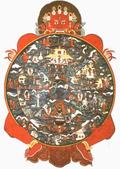 I probably need to explain the previous poem, and the story of Nachiketas, and my own connection with it. I'll tell all this from my point of view... which might seem a bit roundabout, but if you're patient I'll get to it.
I probably need to explain the previous poem, and the story of Nachiketas, and my own connection with it. I'll tell all this from my point of view... which might seem a bit roundabout, but if you're patient I'll get to it.
In the late 1980s and early 1990s, there were three powerful forces keeping me going after I was diagnosed HIV+; they included my brilliant Jungian analyst Mitch Evans, my equally brilliant writing teacher Terry Wolverton (who was running an HIV writing workshop), and Ma Jaya Sati Bhagavati. Ma Jaya, as she is known, is a spiritual teacher with an ashram in eastern Florida, about midway up the coast; she is an amazing and extremely dramatic woman – just one of her many facets is a powerful focus on AIDS activism. In the late 1980s one of her gurubais (or disciples), who also happened to be my AIDS Project LA 'buddy' (i.e. the guy who checked on me, talked to me, saw that I got my groceries, etc.), brought me to meet her on the first of a series of visits she made to Los Angeles (and later San Francisco). Although I am not a particularly religious person – I've never done any formal practice in relation to the ashram – Ma and many of her gurubais are close friends, and an important part of the past eighteen years of my life.
One thing Ma typically does is give people a spiritual name; such names are usually taken from the Hindu pantheon and legendary figures, or related names associated with their qualities or strengths. After I'd known her for a year, she still had not given me a name – as far as I knew; she called me 'Poet' (a real honor of a name, of course!) but nothing else. When I finally asked about this, she admitted that she had a name for me but was concerned that I, and in fact her gurubais, might find the name kind of alarming. When I insisted, she said my name was Nachiketas – and that he was the boy who made friends with Death. I was, and am, frankly proud of the name – it indicates a certain toughness, a certain unafraid quality, that I've discovered in myself over the years, underneath the layers of oversensitivity and complaining that are probably more obvious.
The story of Nachiketas? Well, it was first explained to me by Thomas Byrom. Thomas was a gay Oxford scholar of Sanskrit, who was dying of cancer while living at the ashram; he published translations of the Dhammapada (a major Random House edition, still in print) and the Ashtavakra Gita (which he titled The Heart of Awareness – Shambhala, 1990). He also made a translation of the Katha Upanishad – the most famous and important of the Upanishads – which was unfortunately unpublished on his death, but I have a bound copy. I don't know if it will ever be possible to publish it, but it seems quite good to me – sophisticated but quite readable. In any case, the Katha Upanishad is the story of Nachiketas. Thomas told me all this over the telephone, in the course of several long conversations in those years; we unfortunately never met face to face, because when I finally visited the ashram he had died, in October 1991; he has a beautiful memorial bench along the river near the ashram.
***Nachiketas was a boy, the son of a Brahmin; his father was making a holy sacrifice, but frankly it wasn't much of a sacrifice – old, skinny oxen, quite unimpressive really; and the boy, who (as we shall see) didn't have much tact, said so. The father, in a rage, told the boy to go to hell: literally hell, to Yama, to the lord of death. Well, the boy was not only direct, he was also extremely literal-minded, so... he went.
And in Hell he stood before Yama's house, but the servants didn't know what to do with him, since Yama was away and this was a living boy; so they left him outside, where he waited for three days. When he returned, the Lord Yama was shamed, as this went against all the laws of hospitality. So Yama offered the boy three boons, whatever he wished to ask. The first wish the boy had was that his father would forgive him; and that was easy enough. The second was that Yama would teach Nachiketas the ritual fire, which he did (I don't understand much of this passage, it's extremely Vedic and archaic, but fortunately fairly short). The third, however, as is right in any good tale, is The Clincher: Nachiketas asks Yama, What is the secret of death?
Yama is not at all pleased at the question, which he says not even the gods are supposed to know; he argues, expostulates, offers the boy riches, anything he wants, and so on. But we have already seen that the boy is rather pig-headed (remember, this is the character I am named for); and finally the god of death has to give in, and he admits: the secret of death is the secret of life.
The story thus leads into the vast explanation of reincarnation which is the main body and heart of the Katha Upanishad. And now you know enough, certainly, to understand the poem – and the name, and what the name suggests. Except – and I almost forgot to say this – its literal meaning, which is: he is just going to wake up.







